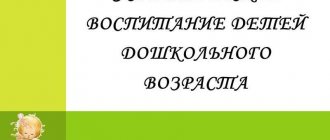Innovative forms of work on the cognitive development of preschool children in the conditions of the Federal State Educational Standard
Basic principles of organizing children's experimentation:
-Connection of theory and practice
-Developmental nature of education and training.
-Individualization and humanization of education.
-Conformity to nature—emphasis on the psychological and age characteristics of preschool children.
-Integrity and consistency of the learning process.
-The interaction of three factors: kindergarten, family, society.
-Success of the experiment:
-Everyone can work using this technology, as it is interesting for both children and adults.
— project activities,
To ensure the cognitive activity of children, the project method is widely used as an option for integrating different types of activities of children from preschool age.
Types of projects in preschool educational institutions
Research and information.
They are distinguished by a clear structure, identification of goals, the presence of a hypothesis, relevance and social significance of the content for all participants, and a set of methods for obtaining and processing information.
Creative.
There is no detailed structure, it is only outlined and further developed in accordance with the interests of the participants (subject to the final result (only the design of the result has a well-thought-out structure; concert program, production script, etc.).
Gaming.
The structure is just being outlined, and the participants take on certain roles (literary characters, fictional heroes" in fictitious situations).
Practice-oriented with a clearly defined result oriented towards social interests and a well-thought-out structure and organization of work.
In any of the above types of projects, there are necessarily components of a game: plot-role-playing, theatrical, didactic, plot-didactic, moving, directorial.
-sign-symbolic means - modeling
.
The most effective form and method of developing the mental abilities of a preschooler is visual modeling.
In cognitive development, three main types of modeling are organized.
1Model as an illustration of a problematic gaming situation
.
The study of the situation is accompanied by the introduction and analysis of the finished model. This option allows you to interest children, clearly illustrates the material, revealing the relationships of the object being studied, and also promotes memorization of the material being studied. In the next lesson, the child reproduces the situation based on the model. For example: Lesovichok brings a model of the parts of the day. The children begin to ask him what it is. Lesovichok says that this is his day, which consists of parts: morning, afternoon, evening, night. Morning is yellow, day is red, evening is blue, night is black. The model is presented in full, its structure and content are explained. 2, Creation of a model by the teacher with the help (participation) of children in the process of solving the problem.
Each component of the model is discussed based on the children’s experience, relationships and the way they are designated are identified, the structure and form of the model are discussed and justified based on the characteristics of the modeling object.
The best option is being discussed. A model is a joint result of cognitive activity. For example: children help gnomes figure out what they are doing and when, what parts of the day they know. Then the children, with the help of the teacher, choose a symbol for each part of the day (several options are offered: different colors and shapes, pictures, symbols). By establishing relationships between the parts of the day and the order in which they appear, children analyze the structure of the model: circle, square, stripe, book, screen, spiral. They discuss and choose the best option together with the gnomes. 3. Independent creation by each child or group of children
of a model as a tool for understanding a problem-game situation. Before organizing such a modeling option, it is very important to create conditions for enriching children’s experience on the research problem: reading literature, looking at pictures, observations, conversations, experimentation, etc. The modeling process itself in this case is generalization, systematization, deepening the child’s ideas, and in some cases reaching a higher (conceptual) level of mastering the material. During the organization of modeling, children are offered a variety of materials to create models. Children creatively design a future model, analyze various options, select the necessary material that matches the design, create a model and defend it, justifying their option. For example: before class, children listen to stories, music, look at pictures, talk with teachers, observe natural phenomena, ask questions to the teacher and parents. They accumulate information and ideas about the phenomenon (object) being studied. During the lesson, a “City of Masters” is organized. Children-masters are invited to help the fez of Time, using a variety of materials to create a day: colored paper, plasticine, construction sets, geometric shapes, natural materials, counting sticks, builder, etc. An educational game task is set to create a model of the day in order to save Time. Children choose a material and construct a model (each their own). Then a “defense” of the models is organized, in which children explain its essence and content. justify the choice of material and design. The federal state standard considers the formation of a child’s cognitive interests and cognitive actions in various activities to be one of the principles of preschool education. (FSES clause 1.4.7.)
The program is based on the following main lines of development of a preschooler:
1) formation of voluntary behavior;
2) mastery of the means and standards of cognitive activity;
3) transition from egocentrism to decentration (the ability to see the world from the point of view of another person),
4) motivational readiness.
These four lines of development determine the content and didactics of preschool education. When developing the proposed program, the accumulated positive experience of modern preschool education was taken into account, as well as new approaches in this area. The program does not claim to be universal. However, it will, firstly, help overcome the negative trend of a simplified understanding of the content of education during preschool childhood and the use of forms that are not specific to it. Therefore, gaming educational technologies are leading in all sections of the educational and cognitive block of the program, and the knowledge offered to children acts as a means of developing the personality of a preschool child. Secondly, it will ensure the continuous and progressive development of the child’s personality at all subsequent stages of education under the conditions of a unified educational system. A comprehensive program for the development and education of preschool children is implemented in specific manuals recommended by the Ministry of Education and Science of the Russian Federation, and methodological recommendations for teachers (see the list of references at the end).
Continuation of continuous courses on all educational lines in primary school is provided by programs and textbooks of the same authors.
Structure and content of the program
The program is presented in the following sections: 1. Age characteristics of children. 2. Organization of life. Protection and promotion of health of preschool children. 3. Physical development. 4. Play activities. 5. Social and personal development. 6. Cognitive activity: • Development of speech and preparation for learning to read and write. • Familiarization with the surrounding world and environmental education • Introduction to mathematics. • Visual activities. 7. Education and development of personal qualities. Each section of the program maintains the general tendency of continuity in the development and upbringing of children, continuity of education, ensuring the child’s successful advancement at each of the successive age stages of his development. The success of the development and upbringing of a preschooler depends on how physically prepared the child is for it. “Physical Development” is important in the program
Health is considered in the program not only as a physical state and well-being, but much more broadly - both from the point of view of awareness of one’s physicality as a way of contact with the world and as a person’s emotional, social, mental and psychological well-being.
7 pages, 3497 words
Work program of the discipline Management Psychology
... characteristics of managers and factors influencing the effectiveness of management activities. Structure and content of the discipline of management psychology. Module title... using modern diagnostic methods to identify comprehensive aspects of management activities, they will acquire the skills to assess the personal characteristics of managers that influence... This program complies with the federal state...
The purpose of physical education classes is to familiarize the child with the basics of a healthy lifestyle, to master a hygienic culture and a culture of movement. The physical development of a preschooler primarily involves the formation of interest in active motor activity and the need for physical self-improvement, enjoying games, movements, and exercises. In the "Game activity"
describes a variety of games (creative, didactic, active, etc.) that ensure the full development of a preschooler.
In play activities, the child actively cooperates with adults and peers, thus enriching his own life experience. Intelligently organized communication plays an important role. The teacher encourages the child to dialogue, directs his efforts to create an atmosphere of trust and mutual understanding; promotes self-expression of the emotional and sensory sphere of preschool children. When a child goes to school, play retains its value as a way of appropriating social experience, communicating with peers, and developing arbitrary behavior. It is no coincidence that the game as a teaching method is given preference in the section “Educational and cognitive activity”
.
Social and personal development
involves the development of a preschooler’s natural curiosity, including interest in himself, in the perception of himself by peers and adults, support in finding his place in the system of social relations and the world around him, and mastering basic social skills, including labor skills.
This section is considered as psychological and pedagogical support for the process of a child’s entry into the world of knowledge and social relations. The section “Cognitive activity”
consists of a number of areas, each of which, while maintaining its independent role in the content of education, is inextricably linked with all the others, consistently implementing the previously identified lines of development of preschoolers.
The teacher instills in children basic learning skills: listen to an adult’s explanations, complete a task without interfering with each other, and show activity and interest in the proposed activity. The teacher supports the children’s efforts to complete the task efficiently with praise and positive evaluation; encourages children's statements and judgments, promotes the development of positive self-esteem in children. The implementation of the principle of continuity, which we declared as the main distinctive feature of the program, is manifested in the fact that in addition to subject content, all programs that provide cognitive activity for preschoolers are focused on the development of not only subject-specific, but also general academic skills. Further development of this group of skills is carried out in primary school through all academic subjects.
2 pages, 741 words
A modern view on the problem of DEVELOPMENT OF THE SUBJECTIVE POSITION of a preschooler
...text follows. Sample format for the text of an article: a modern view of the problem of DEVELOPMENT OF THE SUBJECTIVE POSITION OF A PRESCHOOL CHILDREN I.I. Ivanova Federal State Budgetary Educational Institution of Higher Education “Tolyatti State University”, Russia Beginning...

